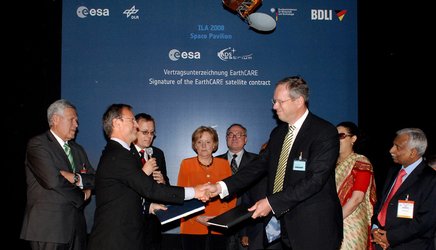Human space exploration in the future
To land on the Moon and on Mars, scientists need a mix of human and robotic missions to know in advance what challenges must be met. A video report from the Berlin International Airshow's Space Pavilion on the future of human exploration in space.
In February 2008, the Agency's long-awaited Columbus science lab was successfully delivered to the International Space Station, and on 3 April, the first Automated Transfer Vehicle - the Jules Verne - made a spectacular automated docking to the Russian ISS module, establishing ESA as a full partner in ISS operations.
To land, first, on the Moon and, later, on Mars - in the 2030 timeframe - scientists need a mix of human and robotic missions to know in advance what challenges must be met - to know how humans can survive for years under microgravity, to scout landing zones and to develop precise navigation and artificial intelligence techniques.
What is the overall concept of a human mission to Mars? And what is the right mix of human/robotic missions and international partners for future missions to the Moon and Mars?















 Germany
Germany
 Austria
Austria
 Belgium
Belgium
 Denmark
Denmark
 Spain
Spain
 Estonia
Estonia
 Finland
Finland
 France
France
 Greece
Greece
 Hungary
Hungary
 Ireland
Ireland
 Italy
Italy
 Luxembourg
Luxembourg
 Norway
Norway
 The Netherlands
The Netherlands
 Poland
Poland
 Portugal
Portugal
 Czechia
Czechia
 Romania
Romania
 United Kingdom
United Kingdom
 Slovenia
Slovenia
 Sweden
Sweden
 Switzerland
Switzerland





























